Improving Last-Mile Delivery When Demand Exceeds Capacity
What steps should you take when demand exceeds your capacity? And how to improve last mile delivery to meet high volumes and rapid fulfillment?
Home > Blog > What Is the Middle Mile Logistics [+How to Optimize It]
Delivery LogisticsFind out what is middle mile logistics, why it’s important for delivery, how it affects the first and last mile and how to optimize it for more efficiency.
Middle mile logistics refers to the operations performed during middle mile delivery. It deals with all the processes and steps that take place in logistics while transporting goods from a fulfillment center or warehouse (inventory) to a distribution hub or retail facility (sales or delivery).
In other words:
It’s the activities required to take goods from suppliers and make them available to consumers.
The middle mile is important because it bridges the gap between both ends of the supply chain.
But that’s why it can be a HUGE disruption to supply chain logistics.
Without control over the middle mile, bottlenecks happen that prevent how you source goods from suppliers. But also how you sell those goods to customers.
It’s the most changing part of the supply chain.
Which means there are a lot of opportunities for delivery optimization in the middle mile.
But it’s exactly why so much inefficiency and inaccuracy can also happen.
Especially if you don’t have enough control over it.
And because of that it’s a place where you can lose a lot of money. (If you’re not careful.)
Unfortunately, it’s often overlooked by companies and logistics experts..
In favor of the first and last mile.
So…
What is the difference between the first, middle and last mile of delivery?
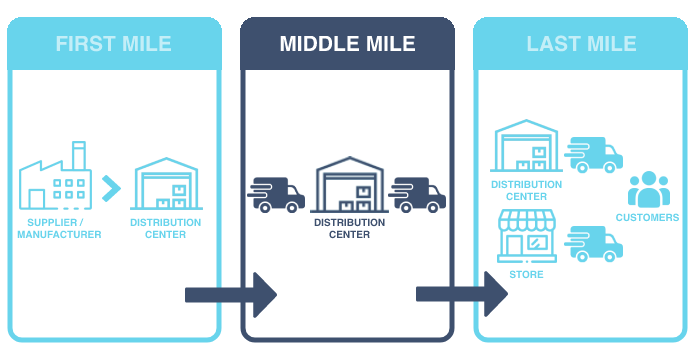
First mile logistics is the first phase of the delivery process. It focuses on transporting items from suppliers and manufacturers to the distribution centers or warehouses.
On the other hand:
Middle mile logistics is the central part of the supply chain and delivery process. It focuses on getting products to distribution hubs. Once there, goods are processed, packed, and prepared for distribution to fulfillment centers closer to customers or to actual stores.
One of the biggest challenges to managing the middle mile is how you plan driver schedules.
This is a problem because at this stage of the supply chain drivers pick-up large order volumes. That makes last-minute changes harder to coordinate, which can have an impact on numerous orders later on.
For example:
Let’s say one of your drivers is responsible for handling middle mile transportation. And that he has to transport 500 orders from suppliers and manufacturers.
If he falls behind schedule, he won’t be able to deliver those orders to distribution centers on time. Your staff won’t process products, store, and pack them on time. And they’ll reach stores and fulfillment centers in the last mile late, as well.
So if a driver is one hour late during pick-up at the middle mile, other drivers may be several hours late at the last mile.
So what about the last mile?
Last mile logistics is the final stage of the supply chain and delivery process. It focuses on delivering goods to end-consumers: your customers.
Here the focus is on lower order volumes and faster delivery times. It’s also the most expensive part of the supply chain, where transportation costs are typically higher than in the middle mile.
Because of that it’s important to optimize your middle mile of delivery, if you want to boost the efficiency of your last mile.
Optimizing middle mile logistics gives you better control of your business and gains you a competitive edge in the industry.
We’ve mentioned above that middle mile operations can have a problem with handling last-minute changes.
But the more you optimize middle mile logistics, the more flexible your supply chain becomes.
Fleets become easier to coordinate, as the drivers have more efficient communication with dispatchers. They get notified of changes in real time and via reliable delivery management software.
For instance, dispatchers are quicker to solve a problem of a delayed driver by notifying another one to take over their middle mile pick-up.
That gives more leeway in changing routes in real-time without disrupting delivery times.
Optimizing middle mile logistics with means such as route optimization software gives you more direct control over the supply chain.
Such as adapting easier to changes in your industry. Even if it’s a high-demand one that relies on the newest technology.
Apart from gaining a more flexible supply chain process, you get more visibility over the whole operations chain.
Using in-house teams also provides a way to reduce inefficiencies and grow your business.
It’s only logical to deduce that optimizing middle mile delivery leads to better last mile delivery.
The final stage of the delivery process benefits from coordination during the middle mile.
Middle mile transportation often handles more packages than last mile delivery. So a more seamless central transportation phase leads to fewer setbacks in the last mile.
That is huge, seeing how last mile drivers deliver to unique locations.
Plus they have multiple stops, spend a lot of time on their routes, and the routes themselves are more complex.
Better last mile delivery translates to better customer experience, too.
Last mile transport carries a lot of risky factors which can endanger your customer loyalty.
Test your customers with expensive and prolonged delivery, and you lose them.
And having problem-free middle mile delivery will give you a hassle-free last mile delivery that gives you time to accommodate customers.
Optimizing mid mile delivery saves you the money you can invest in other parts of your business.
You save in multiple factors you use in middle mile operations, such as:
And businesses that use in-house teams for middle mile delivery don’t spend money on third-party logistics companies.
The businesses control both ends of their supply chain, and after optimizing the middle mile they can more efficiently deal with inefficiencies.
Not all companies are paying attention to middle mile transportation and optimization.
That gives you room to elbow your way in. But bear in mind that giants like Walmart and
Amazon are paying attention to all delivery stages.
So while it’s difficult to keep up with them, as a smaller company you can stand apart from other SMEs (small- and medium-sized enterprises) with your speedier deliveries and more accurate ETAs.
All thanks to optimized middle mile management.
There are various ways of optimizing middle mile logistics.
If you read above the benefits middle mile optimization gives you, you have an idea of how to perfect the middle mile.
Building your teams to handle the middle mile is much more effective than hiring a third party.
So having an in-house team to deal with all three stages of delivery is a way of retaining control of both ends of the supply chain.
That pays off later, as your team and you will better know where the bottlenecks are and how to deal with them painlessly.
Other information you will get are things such as knowing where you can slash some delivery costs in the last mile.
After all, you are the expert for your business.
And challenging your team to become knowledgeable - from the dispatchers to packing crew, to the drivers - gives you a workforce that will effectively deal with problems that appear along the supply chain.
A big chunk of time is saved with effective inventory management and quick loading times.
To Improve middle mile management, use a warehouse management system (WMS).
These tools allow your team to quickly pick and pack orders, and prepare them for loading into vehicles.
Another thing that helps inventory control is tracking order fulfillment levels. That means knowing what items arrive and ship out. And when that happens.
That way you won’t risk running out specific products, which would undoubtedly slow down your delivery operations.
Keeping your stock in check will help keep up with your middle mile logistics.
You can do so by setting minimum stock levels. And by getting rid of obsolete and slow-moving inventory that takes up precious space.
And of course, you need to minimize damage. Broken items, lost orders, and small theft - all of that accumulates into a problem with inventory control.
While you should leave some space for such situations (they’re somewhat inevitable), you should strive for optimal inventory control with minimum damage.
High warehouse throughput means you have good inventory control. And managing shipping routes between transit warehouses and depot hubs is one of the most complicated tasks.
So to ensure good results, enlist the help of a proper software program for route optimization and fleet management.
Another way to improve middle mile efficiency is to use route optimization software.
This is a tool that allows you to automatically plan routes with multiple stops, schedule pick-ups and drop-offs, dispatch drivers, and manage middle mile transportation from end to end:
It’s also an optimization solution. Which means you can raise the efficiency of your middle and last mile operations based on numerous factors, such as vehicle capacity, delivery speed, and accuracy.
That will reduce the number of delivery steps and lower the number of human errors that would also slow down your middle mile. And increase the effectiveness of your last mile delivery.
Route optimization software lets you minimize downtime, find the most efficient routes, and handle your fleet capacity with ease.
Solutions like eLogii allow you to import tasks automatically via routing API or .CSV uploads:
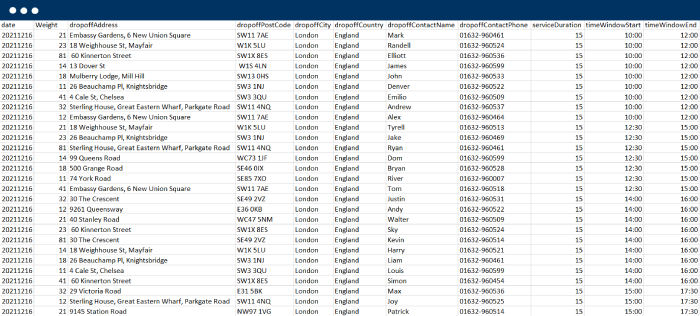
Plan better delivery schedules, and track drivers, and routes in real-time:
![]()
Monitor accurate estimated times of arrival and departure:
![]()
Save time on communicating with drivers using automated dispatch via the driver app:
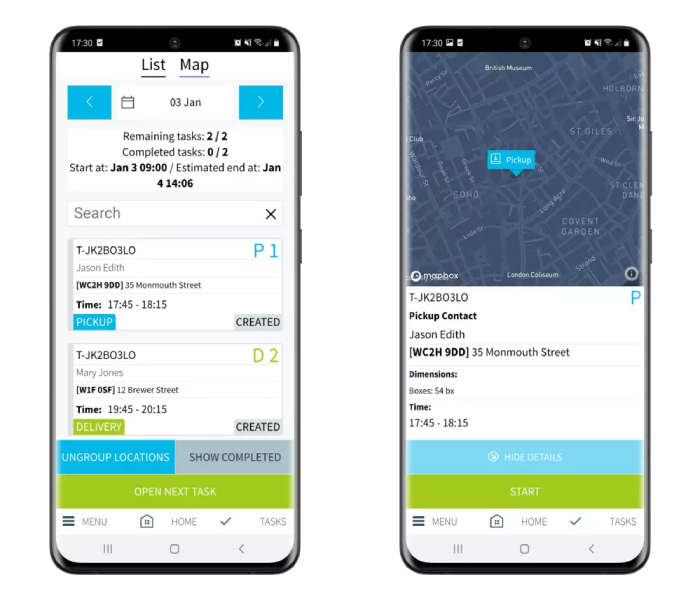
Allowing drivers to collect proof of delivery (POD) with their phones:
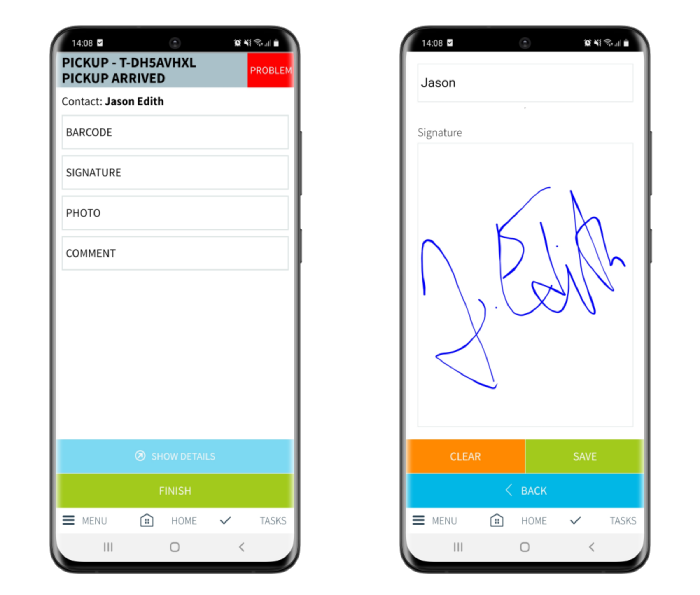
And much more.

Route optimization software like eLogii lets you tailor your dashboard to your needs.
After you pick out a routing solution, implement it, and integrate it with other software you use, you can start making the most of it.
Before you begin route planning and scheduling, you will customize the parameters you follow.
That way you will optimize middle mile operations without overspending.
You can fine-tune your software by specifying parameters such as:

That way, your middle mile will be more in line with your business capacity and your team’s maximum efforts.
Having a clear overview of the parameters important to you will make it easier for you to keep track of and spot obstacles in your logistics process.
You will know what aspects of your business to keep, and which need urgent action.
Down the line, this means saving money and making hefty return investments!
We’ve hinted above the importance of having an overview of your customized parameters.
To truly have your hard work pay off, you should regularly check your reports and have your team analyze them.
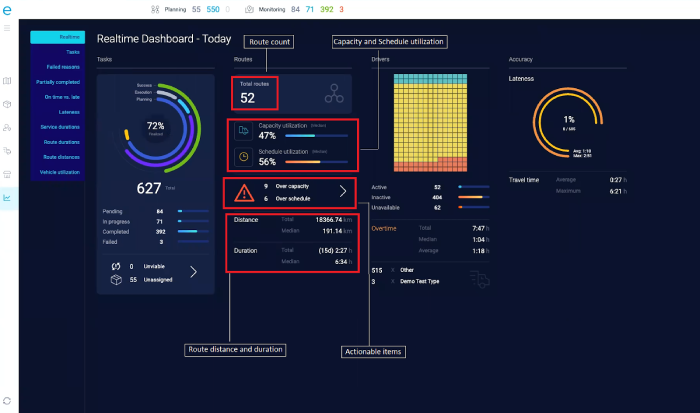
Routing software offers an intuitive dashboard where you can look up relevant middle mile KPIs such as:
While it’s easy to dismiss middle mile delivery, as the last mile often takes the spotlight, we’ve shown that the middle mile can make or break a logistics operation.
Middle mile transportation has exciting opportunities that lurk in automatization, and that’s easily accessible through things like route optimization software.
So if you’re looking to boost your ROI and improve the last mile, look up to giants such as Amazon and Walmart - start mending your middle mile today!
What steps should you take when demand exceeds your capacity? And how to improve last mile delivery to meet high volumes and rapid fulfillment?
This is a complete guide to last-mile delivery. Learn: What is last-mile delivery? How it works? How to improve your last-mile operations? +more
See how the landscape of e-commerce last-mile delivery is changing and what to do to stay ahead of the curb (+ the best solution for this problem).
Be the first to know when new articles are released. eLogii has a market-leading blog and resources centre designed specifically to help business across countless distribution and field-services sub sectors worldwide to succeed with actionable content and tips.
